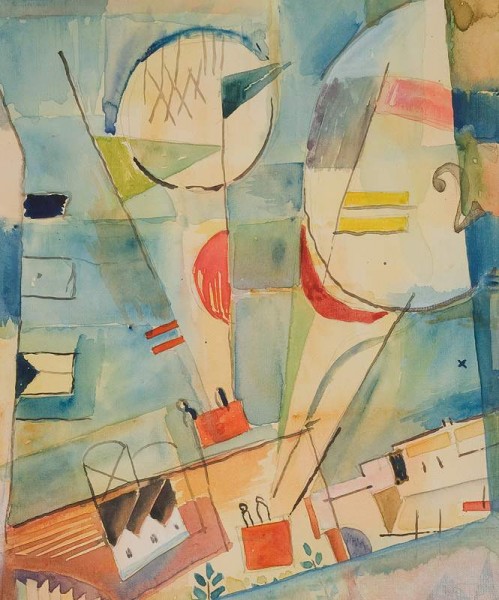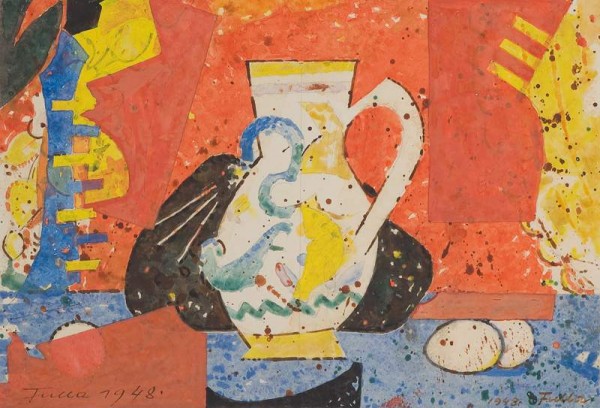An exhibition of works by Ľudovít Fulla entitled Small Forms – Draft Paintings, commemorating the 110th anniversary of his birth (his exact date of birth is February 27), opened for the public on January 11, 2012, in the exhibition hall of the Ľudovít Fulla Gallery in Ružomberok. Visitors have a rare chance to see the portfolio of Fulla’s works from the collection of SNG’s Ľudovít Fulla Gallery in Ružomberok.
It consists of a set of intimate watercolours that served as drafts for the painter’s later oil paintings, documenting the process of their creation. Fulla himself partially revealed the background of his creative process: “When I don’t work, that’s when I actually create the most, because a painting, before it reaches the canvas, goes through a long train of preparatory thought, which in itself is not demonstrated in any particular way ... The birth of an idea is like the weather – I nurture it for quite a long time inside myself until it is ripe.” In other words, these ‘ideas’ are imagined and thus materialised ideal shapes. Fulla prudently and carefully ‘recorded’ them onto his own ‘memory plate’, inscribed them in the virtual matrix of his visual imagination. From there and at any time, he was later able to pick any of the already ‘materialised’ forms, its fragments or a details, or put together new ones, but mutually related – chained together – image entities. The actual execution of the idea that he carried in his mind was equally slow and thought out. Fulla prepared each of his works quite meticulously; his studio included a special tracing table; he even used a magnifying glass for enlarging the patterns he painted. For each larger painting, he created a smaller one – an accurate and precise rendition of the basic composition, shapes and tonal relations – a so-called draft painting. This exhibition provides an opportunity to admire – on a smaller scale – the ‘future’ paintings, many of which are presented in the permanent exposition, e.g.: The Crucifixion (Ukrižovanie), 1941, The Slovak Bride (Slovenská nevesta), 1947, Jánošík On A White Horse (Jánošík na bielom koni), 1948; others can be identified on the basis of small watercolours, because the ‘large’ paintings are placed in private collections not available to the public, e.g. Abandoned House (Opustený dom), 1946, Recruit (Regrút), 1947, Still Life With A Jug (Zátišie s krčahom), 1948, Bethlehem / Christmas (Betlehem / Vianoce), 1950, and other works. In a way, these are miniature jewels – the ‘great small things’ – which bear witness to their author’s artistic mastery. Every encounter with his work is a small festivity, pleasing the eye and soothing the soul...
Ľudovít Fulla (1902 – 1980) is one of the most distinctive figures of the Slovak fine art in the 20th century. His new stylish quality posed the question of whether, with regard to art, it is possible to be both European and Slovak at the same time – to which he was looking for a meaningful answer. Since 1930s, his work combined techniques inspired by contemporary avant-garde painting, folk art, children’s creative expression, iconographic painting and medieval art. The result is an original artistic language characteristic for its synthesis of a rational and constructive structural character of shape with intensive and emotional colouring. In Fulla’s art, the traditions of East and West meet in an authentic way with conceptual and rational thinking, mental and emotional openness, playfulness and spiritual ideals of Christianity. Fulla won the Grand Prix at the 1937 Paris International Exposition. He bequeathed his work to the nation; it is now presented in the Ľudovít Fulla Gallery in Ružomberok, which is governed by the Slovak National Gallery. Ľudovít Fulla was active in the fields of painting, graphics, drawing, scenic design, typography and book illustration.


